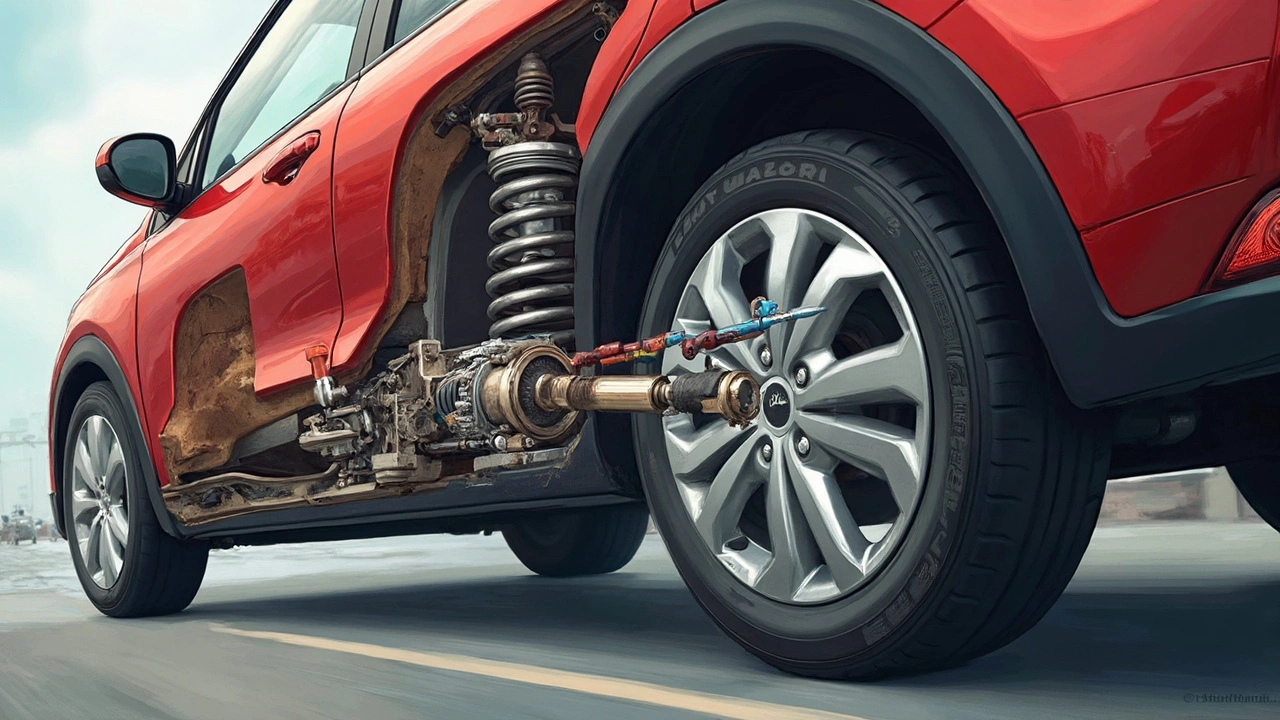What Happens If Suspension Is Too Soft? Real-World Trouble and Simple Fixes
 May, 13 2025
May, 13 2025
Think your car's soft suspension makes every drive cozy? It’s not that simple. While a cushy ride can feel amazing over bumps and potholes, too much softness in the suspension setting can turn those good vibes into real problems.
If you’ve ever noticed that your car leans hard in corners or feels floaty at highway speeds, you might be dealing with a suspension that’s just too soft. That marshmallow feel can feel sweet for five minutes, but it comes at the expense of control and safety. Quick stops, sharp turns, or even hitting a wavy road can send your car bouncing like a boat in rough water.
Before you chalk it up to personal taste, it’s worth understanding how a too-soft suspension affects not just your comfort, but your car’s stability, wear on other parts, and your peace of mind behind the wheel. There’s a sweet spot between harsh and floaty, and hitting it could save your car—and maybe even your neck—down the road.
- Soft Suspension: Comfort at a Cost
- Handling Problems You Can't Ignore
- Why Safety Takes a Hit
- How to Fix or Adjust a Too-Soft Suspension
Soft Suspension: Comfort at a Cost
If your car feels like it’s gliding over every bump and dip, you might think you’ve got the perfect setup. Soft suspension, by design, soaks up road imperfections, making even rough city streets or old country roads feel smooth. Drivers often pick softer setups for daily commutes or long road trips because it reduces the jolts and shakes that can wear you out.
But there’s a tradeoff hiding under all that comfort. With a soft suspension, your car’s body tends to move more—especially when turning, braking, or accelerating. This extra lean isn’t just a weird feeling; it’s your tires losing grip and your steering getting less precise. In real-world terms, the car might sway more in corners or nose-dive when you hit the brakes hard. It sounds small, but this can add up if you have to swerve or stop quickly.
Another thing to keep in mind: when the suspension is set too soft, the car’s weight shifts a lot. That means more wear and tear on the springs, shocks, and even your tires. Over time, you might notice uneven tire wear or hear creaks and groans from under the car, especially if you drive over speed bumps or potholes regularly.
Auto experts often say that there’s no free lunch here. While the ride is cushy, the price is paid in control and safety. This balance matters a lot more than most people realize—especially if you load up your car with passengers or cargo, because extra weight can make soft suspension even less stable.
If you’re shopping for upgrades or looking at new cars, keep an eye on suspension specs. Try taking a test drive on twisty roads or at highway speeds to really feel how the ride changes. Comfort is great, but it shouldn’t come at the cost of feeling safe and in control when it matters most.
Handling Problems You Can't Ignore
If your car’s suspension is too soft, you’ll notice the effects every time you hit the road. That "floaty" feel isn’t just annoying—it actually makes your car less stable and predictable, especially when taking corners, going over dips, or hitting a series of bumps.
The most common sign is excessive body roll. When you turn, the car leans way more than it should. This can make you feel like you might tip over, even at regular speeds. That’s not just uncomfortable—it’s a real problem for safety.
Another headache? Nosedive under braking. When you hit the brakes hard, the car’s front end sinks way down. Not only does this make stopping distances longer, it also makes the steering feel light and less responsive. Plus, if you have to swerve or change lanes quickly, a super-soft suspension makes it harder to keep the car controlled.
Going over speed bumps or uneven roads? With soft soft suspension, you might bottom out—where the suspension compresses all the way and bumps against the stops. Over time, this can wear out your shocks, struts, and the bushings that keep things tight. Suddenly, a smooth ride isn’t worth the extra trips to the mechanic.
- If your car feels wobbly at highway speeds or hops around when you hit a bump, don’t ignore it. That means you’re not getting full traction, and your tires can actually lose contact with the road.
- Steering might also feel disconnected. Instead of sharp, immediate response, you get a dull, delayed reaction that can be dangerous if you ever need to dodge something quickly.
- And as a bonus tip: drivers with heavy loads or full carloads will notice it even more—soft suspensions get worse as the weight goes up.
The bottom line? If your car doesn’t handle like you expect, especially when it matters most, check the suspension. Adjusting or replacing the key parts can turn a boat back into a car—and make every drive a whole lot safer.

Why Safety Takes a Hit
If your car’s suspension is way too soft, the risks go up, not down. Most people only think about ride comfort, but the real issue is what happens when you actually need your car to respond fast—like sudden braking, swerving to avoid something, or dealing with nasty weather.
When suspension is soft, your vehicle leans a lot more during turns. This extra body roll can mess with your grip, especially in quick maneuvers or on slippery roads. Cars are designed to keep their tires planted for a reason—when they don’t, stopping distances grow longer and steering can feel disconnected. In fact, the National Highway Traffic Safety Administration (NHTSA) has noted that poor suspension is a key factor in many rollover accidents and loss-of-control situations.
Here’s a quick look at how soft suspension impacts real-world safety:
- soft suspension lets the car nose-dive or squat more during hard braking and acceleration. This throws off balance and makes it harder for the tires to keep grip.
- Big, floaty movements over bumps mean your wheels can actually lose contact with the road for a split second. Less tire on the ground means less control.
- More roll in corners increases the risk of a rollover, especially if your car is taller or has a high center of gravity, like many SUVs and trucks.
| Problem | Impact |
|---|---|
| Longer Stopping Distance | Extra body movement wastes time, adding feet to your braking distance. |
| Loss of Traction | Tires lose contact during bounces, especially after bumps or dips. |
| Poor Load Carrying | Soft setups sag more under weight, making handling even worse when the car is full. |
| Increased Rollover Risk | More body roll makes tall vehicles especially wobbly in emergencies. |
Safety tech like ABS, stability control, and advanced tires can help, but none of that can fully make up for suspension parts that just aren’t up to the job. If your car is rolling like a small boat, it’s time to take safety seriously and look at some changes.
How to Fix or Adjust a Too-Soft Suspension
If your ride feels like a bouncing couch, you don’t have to live with it. Fixing a soft suspension often starts with a simple check and sometimes needs parts swapped or upgraded. Here’s what really works.
First, pop the hood and take a look at your shocks and struts. If your car bounces more than once when you push down on the fender, chances are the shocks are shot. Worn-out shocks and struts are the usual suspects behind that loose, floaty feel. Upgrading these parts to stiffer or sport-tuned versions isn’t just for racers—regular drivers notice firmer handling and less roll in the curves. Always go with options made for your vehicle type and your actual driving needs, not just something with a cool brand name.
Springs are the next place to look. Some cars come with soft springs to maximize comfort, but that can backfire on twisty roads. Swapping to stiffer coil springs can make a surprising difference, especially if you're hauling heavy loads or like a sportier drive. It’s not a DIY job for most people, though, so don’t hesitate to ask a suspension shop for advice or installation.
If you have adjustable suspension (pretty common on newer models or trucks with towing packages), you’re in luck. Tweaking the settings is usually just a matter of turning a dial or using dashboard controls. Go gradually—crank it too stiff and you’ll feel every pebble. A lot of experienced drivers keep a notepad in the car and jot down how each change feels on their daily route. It sounds obsessive, but it works.
- Check your tire pressure. Under-inflated tires make a car feel even sloppier and exaggerate suspension issues.
- Upgrade sway bars. Thicker sway bars (also called anti-roll bars) cut down on body roll. They’re a favorite cheap hack for cars that lean too much in turns.
- Don’t ignore worn bushings or mounts. These rubber parts act like cushions for your suspension. When they wear out, you’ll feel more wobble and less control.
If you’re trying to fix things on a budget, start with the basics—a suspension inspection and a set of decent shocks. Avoid rock-bottom deals and stick to brands recommended by people who drive like you do. A quick chat with a local mechanic or some time in a car owners’ forum can help you skip expensive trial and error.